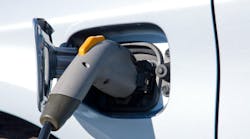The economic signals for trucking's recovery are mixed, according to truck manufacturing executives attending the Mid-America Trucking Show. Positive economic indicators — such as the continuing boom in home construction and rising freight volumes — have helped boost demand for new trucks, especially from TL carriers and vocational fleets. Yet tight credit, high insurance rates, and the uncertainty surrounding emission*compliant '02 engines may overwhelm any economic improvements, they added.
“The truckload segment boosted its purchases in the first two months of this year,” said Susan Alt, vp-marketing for Volvo Trucks North America. “We think that was an artificial increase, however, in response to the impending introduction of '02-compliant engines. Also, there is no credit out there for small operators, so owner-operators are not buying. LTL carriers are still buying at the same level as last year, though.”
Alt added that truck sales won't really improve until the trucking industry gets a real rate increase, one that exceeds inflation. “Nothing will bust wide open until that happens.”
Ed Caudill, general manager for Kenworth Truck Co., said some positive trends include a projected 2% to 3% rise in truck tonnage this year, along with strong growth in the housing market. “The strong housing market in particular has boosted demand for vocational trucks,” Caudill said. “Also, continued low interest rates have made it more affordable to buy trucks.”
On the flip side, however, Caudill noted that the continuing glut of used trucks on the market continues to depress vehicle residual values.
“The trucking industry still has many challenges to face, but demand for trucks is increasing slightly,” said Nick Panza, Peterbilt Motors' general manager. “Credit remains tight….(and) the spiraling rise of insurance premiums — anywhere from 30% to 100% — continues to be a problem. Freight rate increases are difficult to get and freight volumes are predicted to be up just 2% in 2002.
“We project industry-wide sales of Class 8 trucks will reach 145,000 units in 2002, down from 150,000 in 2001, with Class 6 and 7 sales staying relatively flat a 90,000 to 95,000 units.” Panza said.
“Market conditions are uncertain at best,” said Freightliner LLC COO Roger Nielsen. “Class 8 orders are ticking up, but there are mitigating factors. While durable goods and factory orders are up, there's been a lack of demand in consumer goods and manufacturing still retains excess capacity.”
Nielsen also noted that Freightliner has seen some large fleets move their purchases forward to avoid buying trucks equipped with '02-compliant engines in October.
Nielsen added that while Freightliner expects the used truck crisis to continue, it will keep investing in used truck operations. He expects the industry's inventory of used trucks will top 200,000 units in 2002.
International Truck & Engine Corp. is particularly worried about fleets “pre-buying” trucks in order to avoid getting equipment powered by new '02 engines. “The spike in demand caused by pre-buying would be a bad thing for us and our industry,” said Steve Keate, president of International's truck group. “We do not want a short-term gain at the expense of long-term production goals.”
Paul Vikner, president and CEO of Mack Trucks, added that while there might be some pre-buy of trucks this year, he believes most won't pursue that strategy. “Some may even purchase used trucks instead of new vehicles to avoid new '02 engines,” he said. “But they're missing a very important point: The EPA's 2002 emission reduction rules are a fact of life. There's no avoiding it.”
For their part, most heavy-duty diesel engine manufacturers used the Mid-America show to unveil their '02 engines with cooled EGR engines. Cummins, Detroit Diesel, Volvo and Mack all displayed their own particular approach to meeting the October emissions requirements, attempting to calm fleet fears over the availability and reliability of the new engines.
The one exception was Caterpillar, which says it won't use cooled EGR. But company officials made the rounds at the show, assuring all they'd have “bridge” engines ready by the Oct. deadline, followed by their fully compliant new engines in late 2003.


